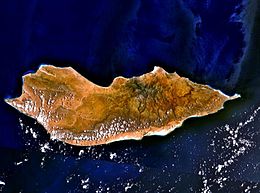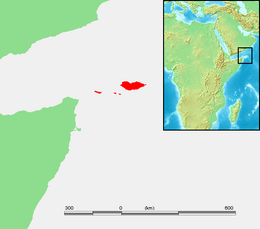Socotra
| Native name: سُقُطْرَى Suquṭra |
|
|---|---|

Landsat view over Socotra
|
|
| Geography | |
| Location | Arabian Sea |
| Coordinates | 12°30′36″N 53°55′12″E / 12.51000°N 53.92000°ECoordinates: 12°30′36″N 53°55′12″E / 12.51000°N 53.92000°E |
| Archipelago | Socotra islands |
| Total islands | 4 |
| Major islands | Socotra, Abd al Kuri, Samhah, Darsah |
| Area | 3,796 km2 (1,466 sq mi) |
| Length | 132 km (82 mi) |
| Width | 50 km (31 mi) |
| Highest elevation | 1,503 m (4,931 ft) |
| Highest point | MĀI point in the Haghier Mountains |
| Administration | |
|
Yemen
|
|
| Governorate | Soqatra |
| Districts |
Hadibu (east) Qulansiyah wa 'Abd-al-Kūrī (west) |
| Largest settlement | Hadibu (pop. 8,545) |
| Demographics | |
| Population | 44,000 |
| Pop. density | 11.3 /km2 (29.3 /sq mi) |
| Ethnic groups | predominantly Soqotris; minority South Arabians, Somalis, Indians, and Bantu |
| Additional information | |
| Official name | Socotra Archipelago |
| Type | Natural |
| Criteria | x |
| Designated | 2008 (32nd session) |
| Reference no. | 1263 |
| State Party |
|
| Region | Arab States |
Socotra (Arabic: سُقُطْرَى Suquṭra), also spelled Soqotra, is an island and a small archipelago of four islands in the Arabian Sea. The territory is part of Yemen, and had long been a subdivision of the Aden Governorate. In 2004, it became attached to the Hadhramaut Governorate, which is much closer to the island than Aden (although the nearest governorate was the Al Mahrah Governorate). In 2013, the archipelago became its own governorate, the Soqatra Governorate.
The island of Socotra constitutes around 95% of the landmass of the archipelago. It lies some 240 kilometres (150 mi) east of the Horn of Africa and 380 kilometres (240 mi) south of the Arabian Peninsula. The island is very isolated and a third of its plant life is found nowhere else on the planet. It has been described as "the most alien-looking place on Earth." The island measures 132 kilometres (82 mi) in length and 49.7 kilometres (30.9 mi) in width.
In the notes to his translation of the Periplus of the Erythraean Sea, G.W.B. Huntingford remarks that the name Suqotra is not Greek in origin, but from the Sanskrit dvīpa ("island") sukhadhara ("supporting, or providing bliss"). Another posited origin of the name is the Arabic suq meaning "market" and qotra meaning "dripping frankincense".
There was initially an Oldowan culture in Socotra. Oldowan stone tools were found in the area around Hadibo by V.A. Zhukov, a member of the Russian Complex Expedition in 2008.
...
Wikipedia

